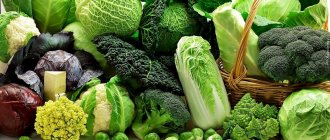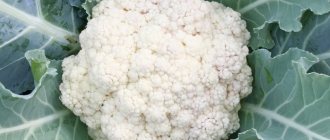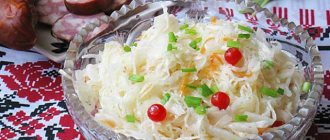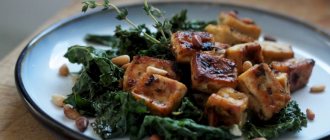Properties of Brussels sprouts
Nutritional value and composition | Vitamins | Minerals
How much does Brussels sprouts cost (average price per 1 kg)?
Moscow and Moscow region.
115 rub.
Brussels sprouts are a type of leafy cabbage. It was developed in the mid-18th century and almost immediately spread throughout many European countries, where it gained universal popularity and respect. In Russia, Brussels sprouts did not become widespread in the mid-19th century. However, the beneficial properties of Brussels sprouts and their excellent taste are no secret to anyone.
Possible harm and contraindications
In most cases, Brussels sprouts bring only benefits. However, sometimes a vegetable can cause harm:
- Diseases of the gastrointestinal tract. For ulcers or gastritis, any type of cabbage provokes painful sensations. This is especially true for raw products. Boiled or stewed Brussels sprouts have a more gentle effect on the gastrointestinal tract, but gastroenterologists recommend limiting the consumption of dishes with this vegetable.
- Increased blood clotting. It is especially dangerous to include dishes with this product on the menu if a person is taking blood-thinning medications. Brussels sprouts thicken the blood and negate the effect of drugs.
- Iodine deficiency. Cruciferous vegetables interfere with the absorption of iodine. The result is hormonal imbalance and thyroid dysfunction.
The vegetable should not be consumed by people with intolerance to certain components of the product. There is also a possibility of an allergic reaction in those who are hypersensitive to other varieties of cabbage.
Benefits of Brussels sprouts
The enormous benefits of Brussels sprouts lie in their rich composition. For example, no other type of cabbage contains as much vitamin C. There is as much of it as black currants. Brussels sprouts are also leaders in terms of the content of whole protein and B vitamins. In the composition of Brussels sprouts, significant amounts of such mineral and absolutely necessary substances as calcium, phosphorus, magnesium, iron, zinc and many others were found.
Brussels sprouts, like all other types of this vegetable, are considered a dietary product. The calorie content of Brussels sprouts is 35 kcal. per 100 gr. Brussels sprouts are high in potassium and low in fiber, so they will be an excellent help for people who want to regain their former slimness. Brussels sprouts are great for feeding young children and the elderly. The benefits of Brussels sprouts are noted for diseases of the heart and blood vessels.
The juice of this vegetable is an indispensable product for people suffering from diabetes, as well as arrhythmia and hypertension. In addition, Brussels sprouts have a positive effect on the respiratory system. It is recommended for bronchitis and asthma. It has been proven that Brussels kaputa has a mild laxative, choleretic, diuretic, and expectorant effect. All this, without a doubt, speaks of the wonderful and truly magical medicinal properties of Brussels sprouts.
It has a general strengthening, anti-scurvy, anti-cancer effect, in addition, it helps eliminate waste and toxins from the human body. Eating this cabbage helps keep the body in good shape. Perhaps the most impressive property of Brussels sprouts is its ability to resist the development of cancerous tumors, a disease that is now extremely widespread. Therefore, it should be consumed as food and as a preventive measure.
Cabbage juice helps to recover from serious illnesses, after operations, as it promotes rapid healing of wounds and increases immunity.
Composition of the product
Brussels sprouts contain many substances necessary for the normal development of the body. In percentage terms, the composition contains the most:
- vitamins C, B1, B2, B6, B9, PP;
- minerals (iron, sodium, calcium, potassium, magnesium, iodine, phosphorus);
- carotene.
Brussels sprouts also contain important amino acids that trigger metabolism and enzymes that catalyze biochemical processes in the body. It contains a large amount of fiber - 1.7%.
Brussels sprouts
Application
Brussels sprouts have one feature that makes many people dislike them. If you overcook it, cabbage develops a strong, specific odor - this is due to sulfur compounds. You need to cook it for several minutes in boiling water so that the heads of cabbage retain their bright green color and hardness. Raw Brussels sprouts are added to salads, soups, casseroles, stuffed, lightly fried with butter and eggs.
Market Analytics
- COVID-19 is changing the rules of the game in the cosmetics market
- Beauty of the future: cosmetic innovations 2020
- New ingredients are the driving force of the cosmetics industry
Convenient search for beauty salons on our website
Beauty salons in Moscow Beauty salons in St. Petersburg Beauty salons in Ekaterinburg Beauty salons in Novosibirsk
Latest blog posts on our website
- Naturecream / Geranium (Pelargonium) oil for skin health and beauty
- Prostye-sovety / Save on a beauty salon: procedures that can be done at home
- Naturecream / Growth Factor - brings back youth?
- Oksana-Lezina / 3 effective abdominal exercises from a fitness instructor for beginners
- Prostye-sovety / Making perfect curls at home
- Prostye-sovety / Which hair removal method to choose
- Naturecream / Wrinkles Puppets
- Naturecream / PEPHA-TIGHT - instant skin lifting
- Naturecream / Blue light - a danger to the skin
- Naturecream / Cocoa Butter – A treat for the skin
Latest forum topics on our website
- Mrs._Smith / Badly sunburned! What to do?((
- Ice / Is it necessary to combine fitness classes with a diet?
- Antonova / What can be used for hair loss?
- Radio operatorKat / Who was on a protein diet?
- Suzanna / Mesotherapy on the face
Other articles in this section
| Stevia Stevia is a South American plant of the Asteraceae family. The Stevia Rebaudiana plant is also known as sweet leaf or sugar leaf. In Latin American countries, it has been used as a sweetener for hundreds of years, but on the European continent they learned about this plant only in the 19th century. |
| Grape leaves Grape leaves have been an integral part of Greek, Turkish, Romanian and Vietnamese cooking since ancient times. They are dark green vegetables, which are recommended to be included in the diet at least 100 g per week. |
| Red onion Red onion stands out among other members of the onion family with its rich red-burgundy, almost purple color. It tastes sweeter, has a more subtle odor and does not cause as much irritation to the mucous membranes as other types of onions. |
| Turnips Turnips are a root vegetable of the cruciferous family. In European and Asian cuisine, the root vegetable itself, stems, and leaves are used. As a rule, turnip fruits are round in shape and can weigh up to 1 kg. Turnips have been known in the Middle East for more than 4 thousand years; they were highly valued by the Greeks and Romans for their nutritional value and sweet taste. Turnips occupied the main place in the diet of the European population until potatoes were brought to Europe. And in Russian cooking it remained the main vegetable until the twentieth century. There are many varieties of turnips, the most common being yellow and white turnips. |
| Lentils (sprouts) Lentils are legumes, therefore rich in proteins, B vitamins and minerals. In terms of nutritional value, it can replace meat products, so it is recommended for vegetarians, and also as a dietary dish. Sprouted lentils are the most beneficial because during germination, nutrients are transferred from the seeds to the sprouts. |
| Boiled cauliflower Cauliflower is an excellent dietary vegetable of the cruciferous family. In appearance, it is very similar to broccoli, only cauliflower florets are larger. Cauliflower is pale greenish in color because it lacks chlorophyll. |
| Sorrel Sorrel is a leafy vegetable similar to spinach. The homeland of this vegetable plant is in Europe, it is especially popular in Eastern European countries. The main component of sorrel is oxalic acid, thanks to which it acquires its unusual sour taste. |
| Head lettuce All types of lettuce are divided into leaf and head lettuce. Thus, cabbage varieties include Iceberg, Batavia and others. Head lettuce is a mid-season variety and is easy to grow. It only needs constant watering, and it is unpretentious to the soil and can withstand light frosts. Lettuce is one of the most popular vegetable crops, which is cultivated in most countries of Europe, America, and Asia. |
| Dried peas Dried peas come in green and yellow colors. Yellow peas are more common in Russia and Northern Europe. Pea pods are harvested when fully ripe and then dried. These peas can be stored for quite a long time, at least a year. Ancient peoples consumed peas for thousands of years. It was only in the 16th century, when sweet green peas appeared, that people began to add fresh peas to their food. In the 19th century Peas have played an important role in the study of genetics. So, the botanist Mendel used it for his breeding experiments. |
| Boiled carrots At first, carrots were grown as a medicine, not a food product. The ancient Greeks and Romans considered it a strong aphrodisiac. The Roman Emperor Caligula held banquets where only carrots were served in order to arouse “wild lust” among his guests. The Dutch developed a variety of orange carrots; before that, carrots of purple, white, red, yellow, and green colors were grown. |
Calorie content and chemical composition
Brussels sprouts are very small in size - they are hardly larger than a regular walnut. There can be up to 50-70 of them on each stem. They are the ones that are eaten.
The calorie content of Brussels sprouts is low and is about 43 kcal/100 g in a fresh product and no more than 36 kcal in a frozen product. That is why it is considered a dietary product and is used in the preparation of special diets aimed at weight loss. However, Brussels sprouts are high in vitamins and nutrients, which is why their nutritional value is significant. It contains a large amount of protein (up to 4.8-5 g), which is characterized by a rich set of amino acids and is not much inferior in characteristics to animal proteins. In addition, there is 2 times more of it in Brussels sprouts than in other varieties of similar crops.
There is little fat content - only 0.3 g per 100 g (the same amount as in cauliflower). The amount of carbohydrates is about 3.1 g - they are 2 times less than in the usual white cabbage. It also contains up to 0.4 g of starch, about 1.3 g of ash, and 4.2 g of dietary fiber. The majority of the mass is occupied by water - about 86 g per 100 g. The composition also contains disaccharides and monosaccharides in the amount of 2.7 g, organic (up to 0.3 g) and unsaturated fatty (up to 0.1 g) acids.
Of particular value is the set of vitamins and minerals contained in the fruits of this crop. Vitamin composition of Brussels sprouts per 100 g:
- A – 50 mcg;
- B1 – 0.1 mg;
- C – 100 mg;
- B2 – 0.2 mg;
- B6 – 0.28 mg;
- E – 1 mg;
- B9 – 31 mcg;
- B5 – 0.4 mg;
- RR – 1.5 mg.
In terms of vitamin C content, this cabbage ranks 6th and surpasses citrus fruits in its content. There is so much of it in 100 grams of the product that this volume satisfies the daily human need for the substance by 77%.
As for microelements, Brussels sprouts are not deprived of them. For example, it contains 375 mg/100 g of potassium, 78 mg of phosphorus, 40 mg of magnesium, and 34 mg of calcium. It is rich in sodium and iron (7 and 1.3 mg/100 g, respectively).
Unfortunately, Brussels sprouts cannot boast of good taste - they are slightly bitter, and even smell a bit harsh, which is why people don’t like them. It is consumed mainly by those people who know about its benefits for the body. However, most of the shortcomings can be eliminated by properly preparing the vegetable.










